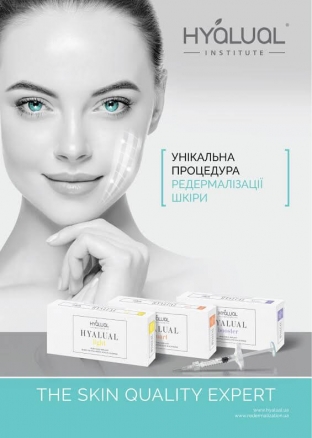The summer period is especially difficult for cosmetologists because of the need to take emergency measures in the fight against photoaging of the skin, when patients neglect the recommendations for sun protection. The arsenal of remedies for restoring damaged skin in the conditions of active summer sun is very limited, since there is a high risk of increasing irritation and causing hyperpigmentation. But also to postpone rehabilitation measures – means to exacerbate age-related changes that will later be difficult to cope with. A good solution in such a situation is the redermalization procedure with Hyalual preparations, the effectiveness of which was learned by our portal.
How to identify the signs of skin photoaging and why it matters
Usually, patients complaining of sun-damaged facial skin present to some extent not only signs of skin photoaging, but also manifestations of natural age-related changes. In order to choose the right treatment tactics, it is important for a cosmetologist to determine which type of skin aging prevails in each case. After all, the signs of skin damage from the sun and from age are significantly different, which means that the measures of influence will be different.
Some signs of skin changes with different types of aging:
|
Skin photoaging |
Aging changes |
|
The epidermis thickens, there are signs of hyperkeratosis |
All layers of the skin are thinning to one degree or another |
|
Along with normal collagen fibers, there are atypical accumulations of elastin |
Thinning and destruction of collagen fibers |
|
The skin retains the ability to synthesize collagen and elastin, the signs of aging are reversible |
Regenerative capabilities are sharply reduced, the components of the intercellular substance are poorly restored |
Photodermatitis is another typical and striking sign of photoaging. The causes of a violent inflammatory reaction of the skin to ultraviolet radiation can be different. Sensitivity often increases after taking drugs that have photosensitizing properties. The list of such drugs is very large and is replenished every year. The skin can become covered with inflamed blisters even with a short exposure to the sun, if perfumes, essential oils were applied to it. Some types of preservatives used in cosmetics sensitize the skin. Even UV filters in cosmetics and skin care products can cause irritation.
Definitely increases the risk of photodermatitis and hyperpigmentation by neglecting the rule not to go out into the active sun after cosmetic peeling, epilation, dermabrasion, hardware resurfacing procedures. However, even in severe cases, photodamage to the skin can be corrected if a course of redermalization with preparations "Hialual".
is carried out without delay.
Why redermalization with Hyalual preparations effective against photoaging of the skin
Skin photoaging is quite reversible, in contrast to age-related changes, and chemical peels, hardware procedures, and many other types of cosmetic effects are used to correct it. But most of these activities have limitations in the summer period, since they themselves have a damaging effect on the skin and carry the risk of side effects.
BLOCKCODE The redermalization procedure, which is carried out with Hyalual preparations containing sodium succinate in combination with high molecular weight hyaluronic acid, meets the requirements of safety and effectiveness in the treatment of skin photoaging to the greatest extent.
The effectiveness of the preparations is based on the activity of sodium succinate – a substance that in our body takes part in biochemical oxidation reactions in cellular mitochondria with the release of energy. Additional attraction of sodium succinate to skin tissue affected by photodamage improves tissue respiration and stimulates metabolic processes, accelerating cell recovery. High molecular weight hyaluronic acid in "Hialual" preparations not only actively moisturizes the skin, but also takes part in the activation of the synthesis of new collagen and elastin fibers, reducing the signs of chronic inflammation in the skin.
How to use the Hyalual preparations correctly? with signs of skin photoaging
The use of drugs "Hialual" for the treatment of photoaging of the skin, a number of clinical studies have been carried out to determine the optimal concentrations and administration techniques.
Some rules for the use of drugs «Hialual» in the treatment of skin photodamage:
|
Indications |
Patient's age |
Injection technique and drug concentration |
|
Minimal signs of photoaging (moderate dryness of the skin, decreased turgor and elasticity, minimal signs of pigmentation changes) - Glogau type 1-2 photoaging. |
28-35 years old. |
Papular, 1.1% |
|
Moderately or strongly pronounced signs of photoaging (moderate or severe dryness, dynamic and static wrinkles, signs of dyschromia are moderately pronounced) – 2-3 type of photoaging according to Glogau |
35-45 years |
Papular/linear, 1.8% |
|
Strongly expressed signs photoaging (significant dryness of the skin, dyschromia, static wrinkles) – 3-4 type of photoaging according to Glogau, as well as the phenomenon of gravitational ptosis |
45- 55 years and older |
Linear 1.8%; 2.2% |
The procedure of redermalization with Hyalual preparations already after the first session gives pleasant visible results, and by the 3rd-4th procedure the lifting effect increases. Thanks to redermalization it is possible to carry out a complex effect on the skin, achieving not only a reduction in the signs of photoaging of the skin, but also a general rejuvenating effect.
|
Skin changes |
Insertion Technique |
Drug Concentration |
|
Sagging of the skin of the face, neck, decollete |
Papular |
1.1% and 1.8% |
|
"Houndstooth" in the corners of the eyes |
Papular |
1.8% |
|
Transverse wrinkles on the neck |
Linear |
1.8% |
|
Lip contour and nasolabial folds |
Linear |
2.2% |
|
Vertical wrinkles on the cheeks |
Reinforcement |
1.8% or 2.2% |
Sun protection (SS) and antioxidant moisturizing sprays (Daily De Luxe) are mandatory recommendations for patients during the summer period.







Add a comment